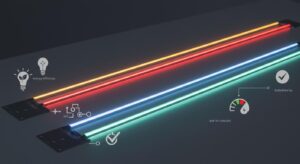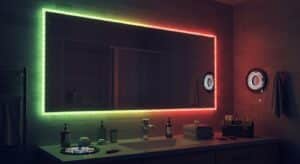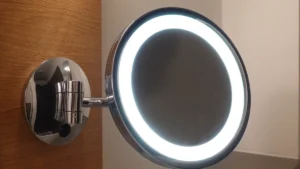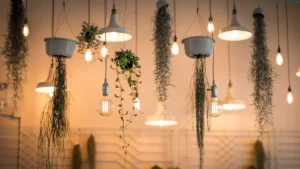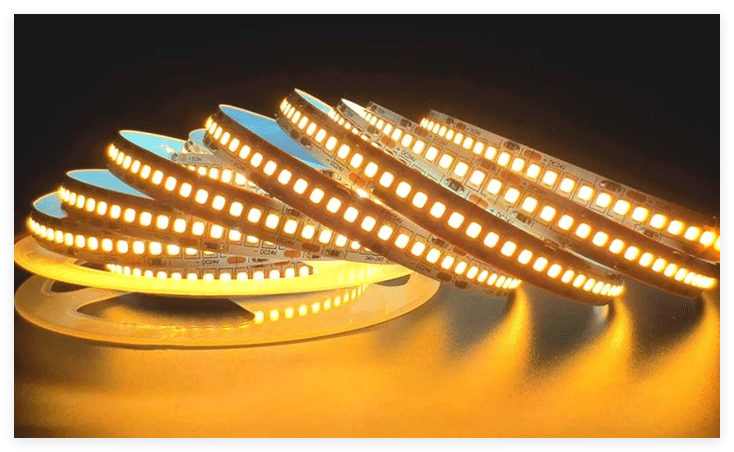
When selecting the best high density LED strip lights or standard LED strips, the key difference lies in the diode count per metre. The best high density LED strip lights feature a greater number of diodes within the same length. Typically, they contain 600 diodes on a 16.4ft strip, whereas standard strips have only 300. An increased number of diodes results in brighter and smoother illumination, effectively reducing gaps between the lights. In contrast, standard strips, with their fewer diodes, produce less even lighting. While they are more economical to operate, the choice ultimately depends on your requirements. The best high density LED strip lights are ideal for achieving bright, seamless lighting, whereas standard strips are more suitable for those seeking affordable, softer illumination.
Key Takeaways
High-density LED strips have more lights per metre. They give brighter and smoother light. Use them for places needing strong brightness.
Standard LED strips cost less and give softer light. They are great for decoration or simple home lighting.
Check energy use when picking LED strips. High-density ones often give more light per watt, saving money on electricity over time.
Installing is important. Match the LED strip’s voltage with the power supply. This avoids damage and keeps it working well.
Think about where you’ll use it. High-density strips suit workspaces, while standard strips are perfect for homes and decorations.
What Are High-Density and Standard LED Strip Lights?
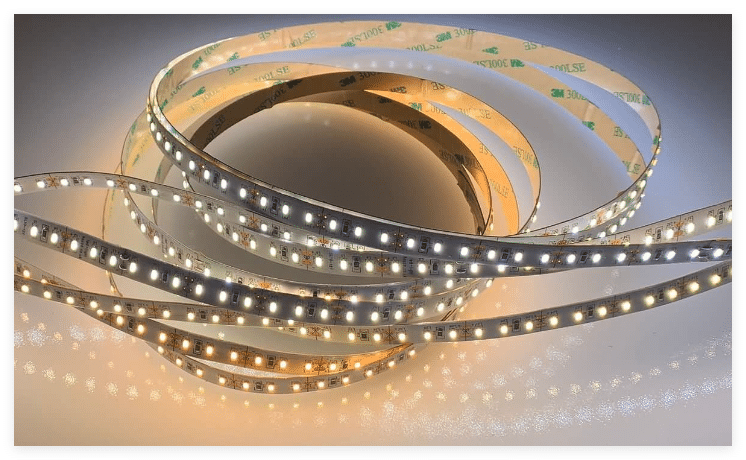
High-Density LED Strip Lights: Definition and Features
High-density LED strip lights have more LEDs per metre. This makes them brighter and gives smoother lighting. They usually have 120 LEDs or more per metre. The close spacing of LEDs reduces gaps, creating even light. These strips are perfect for areas needing strong, bright lighting.
One example is the High Density 2835 Full Spectrum CRI90 Flexible LED Strip Light. It has 22-24 lumens per LED and a 120° beam angle. It uses 19.2W per metre and lasts up to 50,000 hours. You can choose from different colours, ranging from 2200K to 6000K, to match your needs.
Specification | Details |
|---|---|
Product name | High Density 2835 Full Spectrum CRI90 Flexible LED Strip Light |
Power (W) | 19.2W/M |
Input voltage | DC24V |
LED quantity | 238 pcs/M |
CRI (Ra) | Ra90 |
CCT (K) | 2200K/2700K/3000K/4000K/5000K/6000K |
Luminous flux | 22-24 lm per LED |
Beam angle | 120° |
LED chip | SMD2835 |
PCB width | 10mm |
Working hours | 50000 hours |
Length | 5000mm (16.4ft) per roll |
Waterproof ratings | IP20/IP54/IP65/IP68 |
Certification | CE, ROHS, cUL, UL listed |
Warranty | 3 years |
These lights are often used in shops, studios, and buildings. They are great for places needing bright and even lighting.
Standard LED Strip Lights: Definition and Features
Standard LED strip lights are cheaper and have fewer LEDs per metre. They usually have 60 LEDs per metre, so the light is less smooth. While not as bright, they are good for basic lighting needs.
These strips have LEDs on a bendable circuit board. They run on low-voltage DC power and come in 5-metre rolls. You can cut them to fit your space, making them flexible for many uses.
Characteristic | Description |
|---|---|
Construction | Consists of individual LED emitters mounted on a flexible circuit board. |
Power Supply | Operates on low-voltage DC power. |
Length | Typically ships in a long reel (16 feet / 5 metres) and can be cut to length. |
LED Density | Usually 18-36 LEDs per foot (60-120 per metre). |
Brightness | Measured in lumens; a good quality strip should provide at least 450 lumens per foot. |
Power Draw | Should be capable of providing 4 watts per foot or more (15 W/meter). |
Colour Temperature (CCT) | Indicates how warm or cool the light appears, ranging from 2700K (warm) to 6500K (cool). |
Colour Rendering Index (CRI) | Measures how accurately colours appear under the light; higher CRI is better for colour accuracy. |
These lights are great for homes, like under cabinets or for decoration. They balance cost and usefulness.
Key Technical Differences: Diode Count, Brightness, and Uniformity
The main difference between high-density and standard strips is the number of LEDs. High-density strips have 120 or more LEDs per metre. Standard strips have about 60 LEDs per metre. This affects how bright and smooth the light looks.
High-density strips are brighter and give even light. They are best for tasks needing clear and bright lighting. Standard strips may have uneven light with visible gaps between LEDs.
Feature | High-Density LED Strips | Standard LED Strips |
|---|---|---|
LEDs per metre | More (e.g., 120 LEDs/m) | Fewer (e.g., 60 LEDs/m) |
Brightness | Higher due to density | Lower unless higher wattage |
Power Consumption | Generally lower per LED | May be higher per LED |
Light Distribution | More even | Potentially uneven |
Visible Hot/Dark Spots | Fewer | More |
Think about what you need before choosing. High-density strips are better for professional use. Standard strips are good for simple or decorative lighting.
Benefits and Drawbacks of High-Density LED Strip Lights
Advantages of High-Density LED Strip Lights
High-density LED strip lights have many benefits for homes and businesses.
Superior Brightness: These lights are very bright because they have more LEDs. Some professional strips can be 25 times brighter than cheaper ones. This makes them great for bright spaces like work areas or shops.
Uniform Light Output: The LEDs are close together, so there are no dark spots. This gives smooth and even lighting, making your setup look better.
Energy Efficiency: Good-quality strips use less energy, giving over 150 lumens per watt. This saves electricity and lowers your bills.
Longevity: These lights can last more than 50,000 hours. They need less maintenance and fewer replacements than regular lights.
Enhanced Colour Accuracy: With a CRI above 80, these lights show colours clearly. This is useful in places like art studios or photo shoots.
Metric | Description |
|---|---|
LED Density | More LEDs mean brighter and smoother light with fewer dark spots. |
Energy Efficiency | High-quality strips save energy by producing over 150 lumens per watt. |
Longevity | They last over 50,000 hours, reducing the need for replacements. |
These features make high-density LED strips a smart and efficient choice for tough lighting needs.
Drawbacks of High-Density LED Strip Lights
Even with their benefits, high-density LED strip lights have some downsides to think about.
Drawback | Description |
|---|---|
Potential Harm from Blue Light | Blue light from cool LEDs can cause glare and harm your eyes, leading to vision problems. |
Blue Light Pollution | Cool white LEDs can disturb sleep by affecting natural body rhythms. |
Voltage Sensitivity | Small voltage changes can affect how well the LEDs work. |
Limited Light Distribution | LEDs shine light in one direction, unlike traditional lights that spread it around. |
Higher Initial Cost | These lights cost more at first but save money over time. |
Incompatibility Issues | Some old lighting systems may not work with LEDs, needing extra spending on new controllers. |
The upfront cost is one of the biggest issues. While they save money later, the high price might put off some buyers. Also, they are sensitive to voltage changes, so proper installation is important.
Another issue is blue light, which can strain your eyes and disturb sleep. Picking the right colour temperature can help avoid this.
Knowing these drawbacks helps you decide wisely when choosing LED strip lights.
Benefits and Drawbacks of Standard LED Strip Lights
Advantages of Standard LED Strip Lights
Standard LED strip lights have many useful features. They are cheaper than high-density strips. This makes them great for projects with tight budgets. Even though they cost less, they work well for simple lighting needs.
These lights also save energy. They use less power but still shine brightly. This helps lower electricity bills over time. You can cut and adjust them to fit your space. This makes them ideal for custom uses like under cabinets or for decoration.
Another benefit is their colour accuracy. Strips with a high CRI of 90+ show colours clearly. This is helpful in shops where products need to look good. In hospitals, a CRI of 98-100 helps doctors see tissue colours better.
Drawbacks of Standard LED Strip Lights
Standard LED strip lights also have some downsides. They have fewer LEDs, so they are less bright. This makes them unsuitable for tasks needing strong light. You might also see gaps between LEDs, which can look uneven.
They may not last as long as high-density strips. In tough conditions, they might wear out faster. While they cost less upfront, repairs could add up later. Their light shines in one direction, which limits how much area they can cover.
Lastly, their brightness might not be enough for professional tasks. They are better for decoration or soft lighting, not for detailed work.
Applications: Picking the Best High Density LED Strip Lights for Your Needs
High-Density LED Strip Lights: Top Uses
High-density LED strip lights are great for places needing bright, even light. They work well in professional and business settings. Shops use these lights to make products look better and attract customers. One big store chain saved 30% on energy and got more customer interest by upgrading its lights with special TIR lenses.
In building projects, these lights create smooth lighting effects. An architecture team used Fresnel lenses with these strips to light up a park. This made the park safer and turned it into a lively community spot. Farms also benefit from these lights. A lettuce farm in California grew crops faster and improved their taste by adjusting the light spectrum. A vertical farm in Singapore cut energy use by 70% and grew more crops per square metre.
Place of Use | What Was Done | Results |
|---|---|---|
Shop Lighting | Changed lights using customised TIR lenses. | Saved 30% energy and boosted customer interest. |
Building Projects | Lit up a park with Fresnel lenses. | Made the park safer and more inviting. |
Farming | Used strong LED strips for hydroponic crops. | Doubled crop cycles and improved taste. |
Vertical Farming | Added adjustable LED lights for plants. | Cut energy use by 70% and grew more crops per square metre. |
These lights are also good for cars, outdoor spaces, and factory controls. They last long and handle high heat, making them reliable for tough jobs.
Standard LED Strip Lights: Top Uses
Standard LED strip lights are affordable and flexible, making them great for homes and decorations. At home, they highlight artwork or design features. They also help with tasks like reading or cooking. For decoration, they create a cosy feel in living rooms or bedrooms.
Outside, these lights brighten gardens and building designs. They light up paths and plants, making spaces look better. They also improve safety by lighting dark areas and keeping intruders away.
In shops, these lights make products stand out and create a welcoming vibe. Cars and boats use them for both looks and practical lighting. Farms use them to give plants the right light for growing.
Indoor Uses:
Highlight artwork or design features.
Provide light for reading or cooking.
Create a warm and cosy atmosphere.
Outdoor Uses:
Light up gardens and pathways.
Show off building designs.
Improve safety by lighting dark spots.
Special Uses:
Make shops look inviting and highlight products.
Add light to cars and boats for style and function.
Help plants grow better with specific light wavelengths.
Standard LED strip lights are a good mix of low cost and usefulness, making them popular for many needs.
Factors to Consider When Choosing LED Strip Lights
Brightness and Lighting Requirements
When picking LED strip lights, brightness is very important. It affects how well the lights suit your space. Brightness is measured in lumens and changes the light quality and mood. High-density LED strips are brighter and work best for places needing strong light, like work areas or shops. Standard strips are less bright but are good for decoration or soft lighting.
Light spread matters too. Diffusers help spread light evenly, removing harsh spots. They create a smooth glow, which is great for display cases, under cabinets, or room lighting. Managing heat also keeps brightness steady. Aluminium profiles help cool the LEDs, making them last longer.
Tip: Choose high-density LED strips with diffusers and heat control for detailed tasks.
Benefit | Description |
|---|---|
Better Light Spread | Gives even lighting without harsh spots for a smooth look. |
Heat Control | Stops overheating, keeping brightness steady and LEDs lasting longer. |
Flexible Use | Works for many needs, from home to business lighting. |
Energy Consumption and Efficiency
LED strip lights use much less energy than older lights. This saves money on electricity and helps the environment. ENERGY STAR-rated LEDs use 75% less energy than regular bulbs. By 2035, LED lighting could save enough energy to match over 92 big power plants.
Good LED strips are also efficient over time. They produce more light per watt than fluorescent tubes. This means they work well while using less power. Over time, this saves a lot of money, making LEDs a smart choice for homes and businesses.
Note: Look for LED strips with high lumens per watt and ENERGY STAR labels for better energy savings.
Factor | Description |
|---|---|
Energy Saving | Uses less power, cutting costs and energy demand. |
Long Life | Lasts thousands of hours, reducing replacements and repairs. |
Eco-Friendly | Lower energy use means fewer carbon emissions and less waste. |
Budget and Cost Considerations
Cost is important when choosing LED strip lights. High-density strips are brighter and save energy but cost more upfront. Standard strips are cheaper and good for smaller budgets. Balancing the starting cost with long-term savings is key to deciding wisely.
The LED market is growing fast because people want energy-saving lights and smart home tech. Experts say the market will grow from USD 2.5 billion in 2023 to USD 7.8 billion by 2032. This shows why knowing market trends and suppliers can help you plan costs better.
Aspect | Details |
|---|---|
Market Growth | Expected to rise from USD 2.5 billion in 2023 to USD 7.8 billion by 2032. |
Growth Rate | Predicted at 13.5%. |
Main Reasons | Demand for energy-saving lights, smart home tech, and awareness about energy use. |
Market Breakdown | Includes regions and sectors like homes, businesses, and factories. |
Tip: Research suppliers to find good prices and reliable products. This helps you save money while getting quality lights.
Installation and Power Supply Needs
Setting up LED strip lights correctly is very important. You must think about voltage, power type, and LED setup. These factors impact how bright, long-lasting, and safe your lights are.
Voltage Compatibility
LED strips need specific voltage levels to work well. Using the wrong voltage can cause damage or uneven lighting. Common voltage types include:
Voltage Type | Description |
|---|---|
12V or 24V | Most LED strips use these voltages. They need matching power supplies. |
USB (5V) | These strips run on 5 volts and connect to USB devices like laptops. |
Mains Voltage | These strips work with mains power for longer runs but need a rectifier. |
Constant Voltage | These strips use resistors but are sensitive to voltage changes. |
Constant Current | These strips keep brightness steady with built-in circuits. |
Always match the power supply voltage to the LED strip. For example, a strip with 3 LEDs in series needs 9 volts (3V x 3 LEDs). Strips with 6 LEDs in series need 18 volts (3V x 6 LEDs). Resistors are often added to stop too much current.
Power Supply Types
Choose a power supply based on your setup. Plug-in adapters are good for temporary use. Hardwired transformers are better for permanent setups. USB-powered strips are portable and great for small projects.
Tip: Make sure the power supply wattage is higher than the total wattage of your LED strip. This avoids overloading.
Installation Guidelines
Plan carefully when installing LED strips to get the best results. Measure the area first. Cut the strip to the right length, following the marked cut lines. Stick the strip using adhesive or mounting clips.
For power connections, you can solder or use connectors. Soldering is stronger but harder to do. Connectors are easier and good for beginners.
Steps for Installation:
Measure the area and cut the strip to fit.
Attach the strip with adhesive or clips.
Connect the strip to the power supply using soldering or connectors.
Test the lights to make sure they work.
Managing Heat and Brightness
LED strips can get hot, which affects their brightness and lifespan. Use aluminium profiles or heat sinks to cool them down. Diffusers help spread light evenly and remove harsh spots.
Note: Managing heat keeps your LED strips safe and makes them last longer.
By following these steps, you can install LED strips properly and pick the right power supply. This ensures your lights work well and suit your space.
COB vs SMD LED Strip: Which Is Better?
What Are COB and SMD LED Strips?
COB (Chip on Board) and SMD (Surface Mounted Device) are two types of LED strip lights. COB strips have many LED chips placed close together on one base. This design gives smooth and even light without gaps. It is great for areas needing bright and seamless lighting.
SMD strips have single LED chips spaced apart on a circuit board. These strips show separate points of light, making them less smooth. They are popular for decoration and simple projects because they are cheaper and flexible.
How Are COB and SMD LED Strips Different?
COB and SMD strips differ in how they work and look. COB strips are brighter, save more energy, and give even light. SMD strips are less bright but cost less and are easier to use.
Feature | COB LED Strips | SMD LED Strips |
|---|---|---|
Brightness | Very bright | Depends on the model |
Light Quality | Smooth, no gaps | Shows separate LEDs |
Energy Use | Saves more energy | Uses slightly more power |
Heat Control | Handles heat better | Average heat control |
Design | Slim and neat | Bulkier with gaps |
Cost | Expensive | Cheaper |
Best Use | Workspaces, décor | Decoration, DIY projects |
Picking the Right LED Strip for Your Needs
Choose COB or SMD strips based on what you need. COB strips are best for bright and smooth lighting in offices or modern designs. They cost more and need good heat control. SMD strips are better for cheaper projects like decorating rooms or gardens. They are easy to install and fit many designs.
For example, COB strips work well for lighting desks or creating sleek effects indoors. SMD strips are great for adding soft light to living rooms or highlighting plants outside. Think about your needs to decide which type suits you best.
Lifespan of LEDs: How Long Do LED Strip Lights Last?
Factors Affecting the Lifespan of LED Strip Lights
How long LED strip lights last depends on many things. Managing heat is very important. Too much heat can harm the LEDs and make them wear out faster. Using aluminium profiles or heat sinks helps cool them down. A good power supply also matters. It keeps the lights working steadily and avoids damage.
The environment also affects how long they last. Humidity and temperature can cause problems. Outdoor LED strips need to be waterproof and sealed to handle bad weather. The drive current and case temperature must stay within safe limits. Pushing the LEDs too hard can make them fail sooner.
LED lifespans are measured with the L70 metric. This shows how long it takes for the brightness to drop to 70% of the original level. For example:
LEDs tested for 5,000 hours may last up to 30,000 hours.
Testing with higher currents and temperatures gives better lifespan estimates.
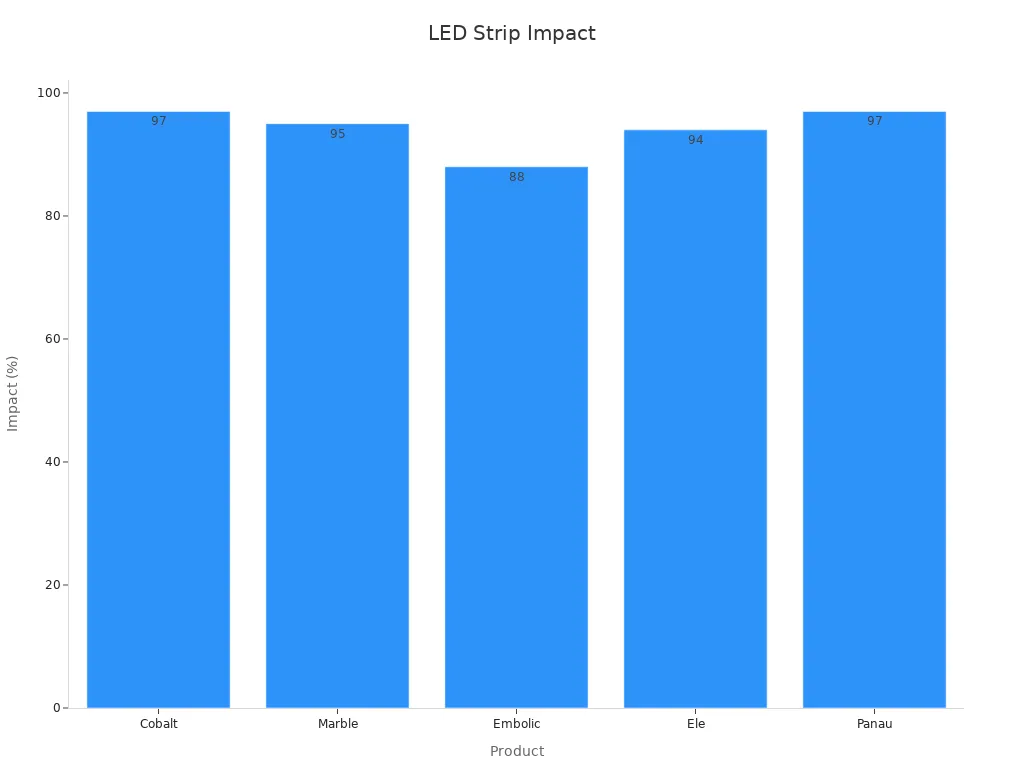
Maintenance Tips to Extend the Lifespan of LEDs
Taking care of your LED strip lights can make them last longer. Check them often and fix any problems quickly to avoid permanent damage. For outdoor use, seal cut points and connections properly to keep water out. Adding extra protective coatings can help them survive tough weather.
Clean the strips with a soft, damp cloth to stop dust from building up. Dust can make them dimmer and less efficient. Don’t bend or twist them too much, as this can break the circuit board. Be gentle when making changes to keep them in good shape.
Tip: Use reliable power supplies and don’t overload the strips to keep them working well for longer.
By following these tips, your LED strips can stay bright and efficient for many years.
Picking between high-density and standard LED strip lights depends on what you need. High-density strips give bright, smooth light. Standard strips are cheaper and offer softer lighting.
Tip: Consider where and why you need the lights. Focus on brightness, energy use, and your budget.
Look at your space and lighting goals. Compare both types to choose wisely. This way, your choice will match your needs and look good too.
FAQ
What is the difference between high-density and standard LED strip lights?
High-density LED strips have more LEDs in each metre. This makes them brighter and gives smoother light. Standard strips have fewer LEDs, so the light is softer and may have gaps. Choose high-density for bright tasks or standard for cheaper decoration.
Can you cut LED strip lights to fit your space?
Yes, LED strips can be cut at marked spots. These marks show where it is safe to cut. Use scissors to carefully cut along these lines. Always check the instructions to avoid damaging the strip.
How do you power LED strip lights?
LED strips need the right power supply to work. Match the strip’s voltage (like 12V or 24V) and wattage with the power source. Plug-in adapters are good for small setups, while transformers are better for permanent ones.
Are LED strip lights waterproof?
Some LED strips are waterproof, like those rated IP65 or IP68. These are good for outdoor areas or damp places. Check the product details to see if it suits your needs.
How do you choose the right colour temperature for LED strips?
Colour temperature changes how a room feels. Warm white (2700K–3000K) gives a cosy feel, while cool white (5000K–6500K) is better for work areas. Think about the room’s purpose before picking a colour.
Tip: Pick warm tones for relaxing spaces and cool tones for work.
See Also
Comparative Analysis of Bright LED Strips for Various Uses
Selecting the Ideal LED Strip Lights for Linear Illumination
In-Depth Comparison of SMD 2835, 5050, and 3528 Strips
